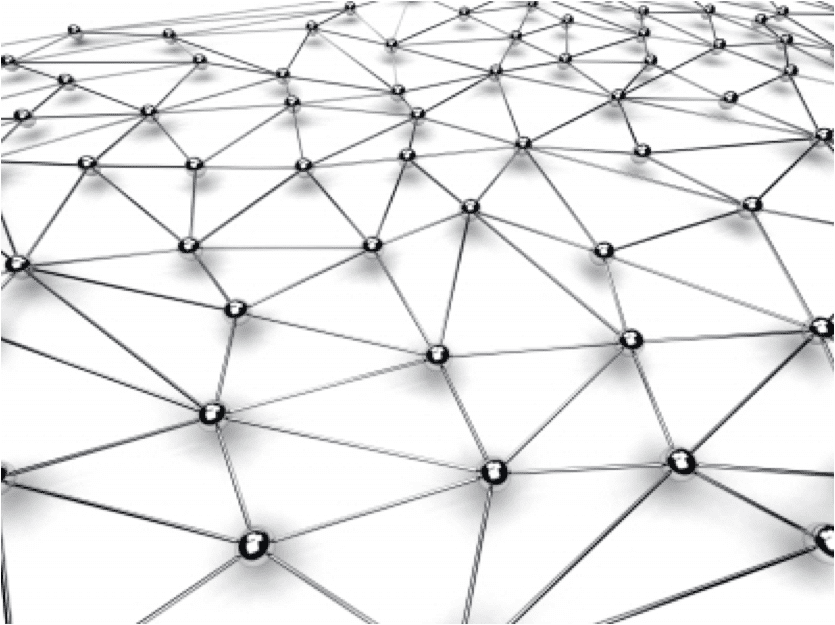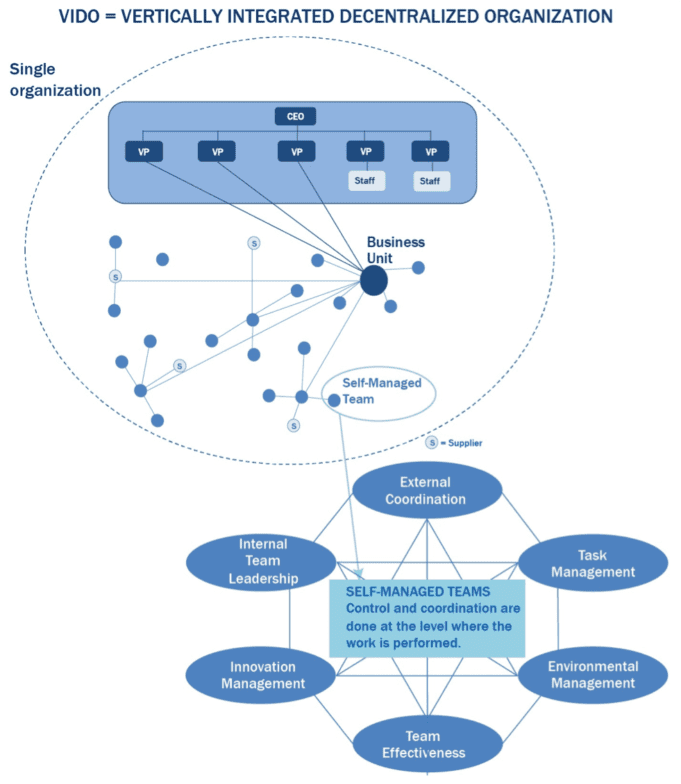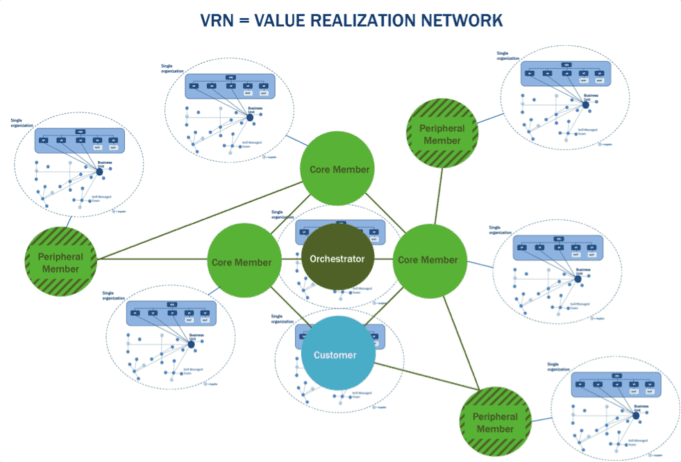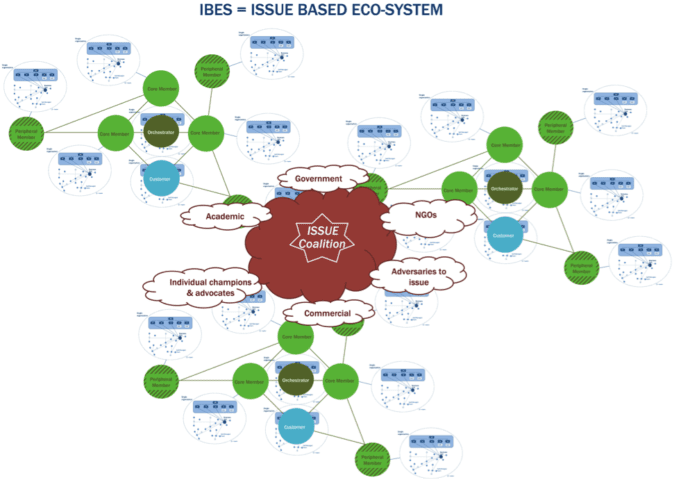Working in, leading and designing agile and adaptable organizations has become highly complex. To optimize both efficiency and innovation, and ultimately meet client needs, enterprises had to look beyond their own organizational boundaries for solutions. In a world where global crowd sourcing can design a water pump for farmers in Africa and homelessness/poverty is a major concern in both developing and developed countries, it has become abundantly clear just how connected we ALL are. This interconnectivity of our social, political, environmental and economic realities impacts every organization’s ability to produce and serve at its full potential. As a result, organizations are designing their structures, roles, relationships, systems and processes to encompass the three levels of interconnectivity and analysis they currently face — their own enterprise or firm, its more immediate network(s) and its even larger and farther reaching ecosystem.
A clear illustration of the tension created between these three levels of organizational interaction and analysis exists within a client system I currently service in the healthcare arena. Although the client has a physical office space (a firm or enterprise boundary), a virtual network of 20 members representing 32 geographical communities advises the firm on strategy and operations. This virtual network, along with five other sister networks, serve and are governed by the citizens of all 32 communities, which cover an area of 55,000 square miles. To further complicate matters, the firm and the six networks operate within the healthcare industry of users, providers and funders (a fairly massive ecosystem). The enterprise is impacted by and impacts the six networks. Both of these smaller systems impact and are impacted by the much larger healthcare ecosystem. Thus the implication for organizational decision makers — designing for interconnectivity (coordination) at all three levels, not merely at the level of the firm.
When considering the three levels of interaction and analysis, how an organization designs to coordinate efficiency and innovation differs at each level. At the firm level, organizations design coordination mechanisms to optimize technology and work processes. Common redesign elements are high participation team-based structures, which enable organizations to control the most predictable variances in their bounded system. At the network level, organizations design mechanisms to develop broader, more effective networks of partners/collaborators. Having a broad network creates greater ability to respond rapidly to dramatic shifts in markets and technologies. Lastly, at the ecosystem (society) level, organizations design coordination mechanisms that create broad coalitions, which develop greater conversation competencies and create large communities with shared values and ideas. These broad-based communities have greater capacity to identify and mitigate large social, ecological and economical issues — poverty, cancer treatment, nuclear disarmament, vaccination for pandemic diseases, etc.
The New Normal generated these three new ‘design contexts’ at the firm, network and societal/ecosystem levels. Each of these design contexts presents new challenges and opportunities for producers and service providers. Each level has different value propositions, high leverage design elements, structures, processes and methods including specific analysis and design tools.
At the firm level (see image below of a vertically-integrated decentralized organization structure — VIDO), ‘what gets designed’ include the core work processes, management and compliance systems, and information flows. These designs may include utilizing tools such as variance analysis, key variance control, business process mapping, statistical analysis and rapid prototyping.
At an organization’s network level (see image below of a value realization network — VRN), design work may involve multiple enterprises to create value as defined by their shared customers. This binds the network together through a commonly held value proposition. The focus of ‘what gets designed’ shifts toward defining a shared value proposition, clarifying governance processes, developing network member capabilities, developing information capital, improving working relationships, and creating the right leadership paradigm. Methods utilized at this level may include tools such as Appreciative Inquiry, Two-stage Search Conference, Human Centered Design, and Value Network and Social Network Analysis.
At the broadest level of interaction, analysis and design, the ecosystem (see image below of an issue-based ecosystem — IBES), large societal problems (e.g., global coordination of responses to pandemics) are the areas of concern. Because these wicked problems affect everyone, but no one sector working independently can resolve them, what gets designed are processes for creating productive dialogue across time and space and building community. The broadly divergent stakeholder groups with widely differing values, competencies, and interests must each be given a voice and be productively engaged. The approaches utilized to bring this disparate set of constituencies together include Search Conferencing, Scenario Planning, Open Space Technology, Innovation Summits, Innovation Studios and Appreciative Inquiry.
Most organizations are able to see and feel the immediate impact their internal and external networks exert on their ability to produce and serve. The more connections we make in life, the more complex our life becomes. On a personal level, when we experience large increases in complexity, our typical human response is to feel stressed. Whether personally or collectively as in organizations, our tendency to resist rather than accept change has us repeating an old pattern — waiting for a crisis to be the motivation for change. The greater challenge before us is to see beyond the stress of dropping old habits and learning new ones and to recognize the opportunity and choice we are facing — to build interconnectivity and community at a level we have not likely experienced previously.
For someone who wishes to see world peace (global interconnectivity) in her lifetime, I am seeing the glimpse of possibility emerging. It is our choice to make it so.
What connection can you enact to bring yourself closer to peace?
For transformation tools that bring greater peace to you and those around you, click here.








